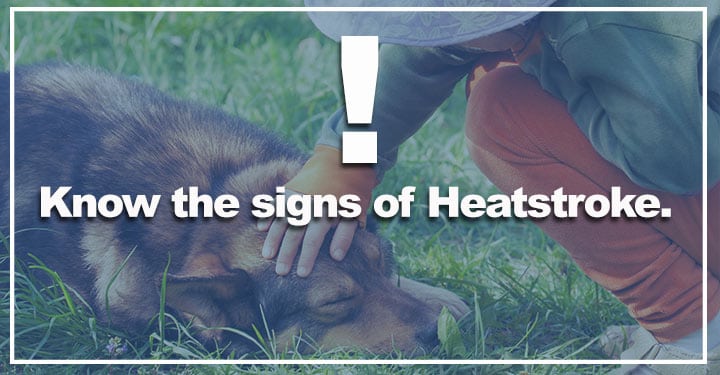
You’re walking along with your 80-pound, long-haired shepherd one warm, sunny afternoon. You’re breaking a bit of a sweat, but you feel just fine in your shorts and tank. But then you look over at Thor, and he’s not looking too good … his eyes are glazed, he’s panting heavily and he’s starting to pull back on the leash.
“But, it’s not that hot,” you say to yourself. “What is up with Thor?”
Thor is probably on his way to having heatstroke, which means he is quickly losing his ability to regulate his body temperature because of an overabundance of heat. Dogs don’t sweat the way we do – they only have sweat glands in their nose and pads of their feet. And their only real recourse when they are overheating is to pant, which sometimes isn’t enough. Add to that the fact that their bodies are covered in fur and their paws are usually in direct contact with hot concrete or asphalt … and well, it’s easy to see how they can get much hotter than we can – fast.
And since heatstroke can quickly lead to irreversible damage to major organs like the kidneys, liver, heart, brain – and can even cause death – it’s important to know the signs.
How Do I Know If My Dog Has Heatstroke?
Normally, a dog’s body temperature is somewhere between 100.5 to 102.5 degrees Fahrenheit, slightly higher than for humans. A dog will start to experience heatstroke at over 105 degrees. At around 106 to 108 degrees, organ damage can occur. Always keep a rectal thermometer handy for your dog and check his temperature if you suspect heatstroke.
Other signs to look out for include:
♦ Excessive panting
♦ Excessive thirst
♦ Glazed eyes
♦ Hyperventilation
♦ Increased salivation
♦ Dry gums that are pale or grayish
♦ Bright or dark red tongue or gums
♦ Rapid or erratic pulse
♦ Weakness
♦ Staggering
♦ Confusion
♦ Inattention
♦ Vomiting
♦ Diarrhea
♦ Rectal bleeding
♦ Collapse
If the overheating isn’t stopped, your dog’s breathing will slow or stop, and he can have seizures or fall into a coma. Obviously, we don’t want any of that to happen. So, what should you do if you think your dog has heatstroke?
My Dog Has Heatstroke, What Do I Do?
Whenever the weather gets warms, it’s a good idea to pay special attention to how your dog is doing. And know your dog: Breeds with “flat faces” like Pugs and Boxers, elderly dogs, puppies and sick dogs are at even greater risk of overheating. Things progress quickly when it comes to heatstroke, so as soon as you detect a problem, act quickly.
Get him into shade.
Since heat is the obvious problem, the goal is to get him out of it and away from direct sunlight.
Apply cool water.
Get water on his inner thighs and stomach where there are more large blood vessels, and on the pads of his feet. Use running water via faucet or hose and avoid submerging your dog in a tub or pool because this could cool him too fast and cause other problems like cardiac arrest and bloat. Also, avoid cold water or ice because these will cause the blood vessels to constrict, slowing blood flow and the cooling process.
Air him out.
To help cool your dog, you want to make sure the water you’re putting on him can evaporate. To that end, you’ll want to avoid covering him up with a wet towel or blanket because rather than allowing the water to evaporate, this will create a sauna effect – which you don’t want. Keep him out of enclosed areas like a kennel; instead, keep him near flowing air like from a fan or air conditioner.
Keep him moving.
Encourage your dog to stand or walk slowly while he’s cooling down, so that his cooled blood can circulate throughout his body.
Give him small amounts of cool – not cold – water.
If he gulps down too much water too fast, it can cause vomiting or bloating.
Give him some chicken or beef broth
…if he doesn’t want water, but avoid human performance drinks.
Get a quick and easy bone broth recipe here!
Get him to the vet.
Once your dog has started to cool down, you can stop your efforts and take him to his vet right away. You don’t want to continue trying to cool down your dog for too long or you’ll risk him getting hypothermia. Your dog will need a veterinary exam even if he seems fine because there may be underlying damage to his organs that you can’t see. Even if he seems normal, the effects of heatstroke can continue for 48 to 72 hours following the initial heatstroke. According to William Grant DVM, the most common cause of death following heatstroke is disseminated intravascular coagulopathy (DIC) which is blood coagulating throughout the body; it can occur hours or days after the heatstroke episode.


